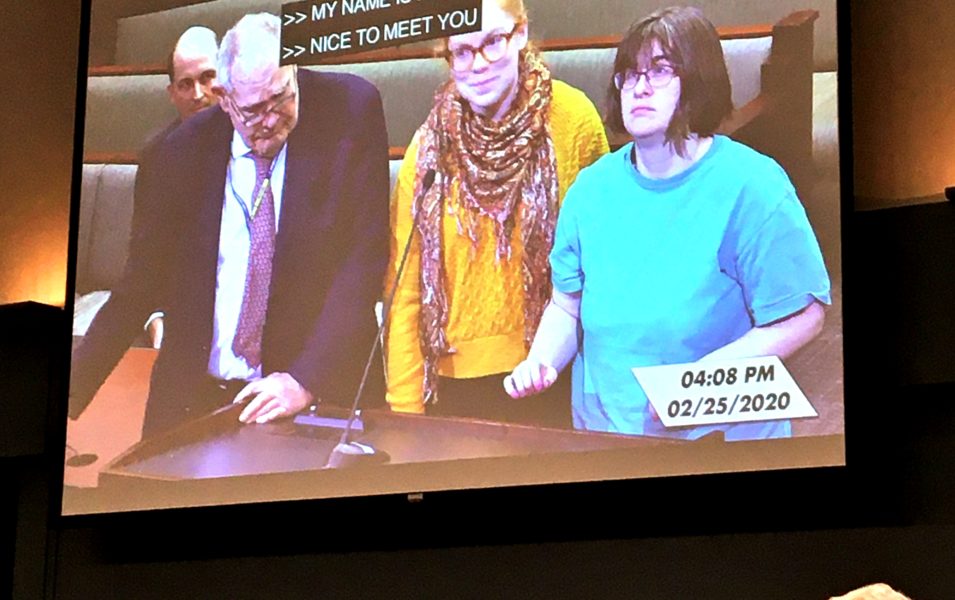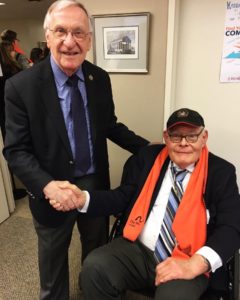
Five years ago the USA was celebrating the 25th anniversary of the Americans with Disabilities Act and Laurie and Eva-Elizabeth were at the center of the celebration – in the White House. Laurie had been hopeful and persistent that she would go to the White House and meet the president and with her ongoing belief the dream came true. For Laurie, that visit was “so happy!” and she especially remembers that the president shook her hand not just once, but two times.
This month we celebrate the 30th anniversary of the Act with the same hope, persistence, and joy that Laurie leads us in and that disability rights activists have led us in for decades. Our world is more accessible today due to activists who were unafraid to speak truth to power, who blocked traffic, staged weeks-long sit-ins, and crawled up the Capitol steps. L’Arche life is as mobile and adventurous as it is (in non-pandemic times) thanks to the Americans with Disabilities Act!
What is the Americans with Disabilities Act?
The Americans with Disabilities Act (ADA) is a civil rights law put into effect in 1990. It bans discrimination against people with disabilities in public life, such as in education, employment, transportation, telecommunications, and building accessibility. It was, and is, a landmark piece of legislation that changed the social and physical landscape of the United States. Prior to the ADA, students with disabilities could be kept out of schools. Our buses did not have ramps or spaces for wheelchairs. Employers didn’t have to make accommodations for employees with disabilities. Closed captioning on important public service announcements wasn’t required.
What does it have to do with L’Arche GWDC?
“If there wasn’t an ADA, and there wasn’t a societal shift in how policy was created and implemented to support people with disabilities, the risk would be that L’Arche could be very insular,” says Eva-Elizabeth Chisholm, Human Services Leader at L’Arche GWDC. Our community wouldn’t be able to lead our normal lives – there would be no going to restaurants, baseball games, trips and vacations. We couldn’t go to many churches, government buildings, or even get on public transportation. “We would be calling the city council saying we tried to go to dinner and had to carry a wheelchair [up the stairs].”
Eva-Elizabeth recalled when Laurie, who is a talented artist, enrolled in a pottery class and L’Arche worked with her to both request accommodations and have her abilities recognized. It was an example of how to “tap into the intent and foundation of the ADA,” explained Eva-Elizabeth. “It’s both to advocate for access and acknowledgement of human dignity and to advocate to not be seen as less than who we are.”
On an organizational level, the Olmstead Act based on Title II of the ADA paved the way for more access to community based services like L’Arche. Led by two women with disabilities in Georgia, Lois Curtis and Elaine Wilson, who wished to live in homes in the community instead of an institution, the Olmstead Act requires that “services to persons with disabilities must be provided ‘in the most integrated setting possible.’”
What does the ADA do?
Thanks to the ADA, the world is more accessible. We’re used to seeing ASL translators or closed captioning on the news. Online spaces are becoming more accessible. Buildings are required to consider accessibility in design.
The Disability rights activist Alice Wong, in a recent interview on The 1A NPR, said “I am incredibly changed by the ADA. I don’t doubt that coming into adulthood and getting to have educational opportunities… that would not have happened without this access.”
“I know that I wouldn’t be here without it [the ADA],” said civil rights lawyer Britney Wilson in the same interview. “And I think especially the anti-discrimination mandate within Title II, specifically when we talk about Olmsted and the right of people with disabilities to live in community and not be institutionalized. I think that’s a particularly important provision for me and for people with disabilities in general.”
Lex Frieden, one of the creators of the ADA, says in an interview in New Mobility that due to the ADA, “There’s been a sea change in the way people in the public view those of us with disabilities, at least those of us who are active and participating in the community.”
How did a more accessible world come to be?
The ADA did not appear out of a vacuum – prior legislation and decades of difficult, sometimes dangerous, work by disability rights advocates made the ADA possible. Eva-Elizabeth explained that by joining L’Arche, “We got to step into the mission of L’Arche and into the work of disability advocacy, like really living in the fruit of other people’s very tireless work and advocacy and energy.”
Before the ADA existed the Rehabilitation Act of 1973 (Rehab Act) paved the way, and particularly Section 504 of the Rehab Act. The government dragged its feet on passing Section 504 and it took massive, ongoing protests by disability rights activists to make it a reality. The 504 Sit In in San Francisco in 1977 is the longest sit-in in a federal building to date – over a hundred disability rights activists walked and rolled into the Department of Health Education welfare building and stayed for 26 days. Many of them came with nothing but a toothbrush and their medication. No food, no beds, no support services, no medical care. And together, they lasted almost a month. They created a “refrigerator” from an AC unit for their medication. They had no computers or cell phones and the telephone lines were cut – so they used ASL to sign press releases through the window. They slept wherever they could find a spot. They took care of each other and many groups took care of them, sending food, supplies, and eventually mattresses.
As one of the leaders of the disability rights movement, Judy Heumann, explains, the sit-in was a culmination of protests big and small, including in government offices around the country, as well as protests that blocked traffic and stopped buses – people with disabilities putting their own bodies on the line in the fight for better access for all people.
When the ADA stalled in the House Committee on Public Works and Transportation, disability rights activists knew they had to take a similar strategy, drawing attention to the issue and spurring the government to act.
American Disabled for Attendant Programs Today (ADAPT) planned a rally and demonstration on March 12th, 1990. People with disabilities left their mobility aids – their wheelchairs and walkers and canes – and crawled up the steps of the Capitol building. With cameras on them, the activists pulled themselves up the stairs, chanting and encouraging one another. These activists included eight-year-old Jennifer Keelan who claimed “I’ll take all night if I have to!” It was, and is, a powerful visual of the many struggles people with disabilities face. Now known as the Capitol Crawl, that demonstration was instrumental in passing the ADA, signed into law on July 26th, 1990.
More work to be done
The impact of the ADA was enormous, but there are still many social and institutional barriers standing in the way of people with disabilities today. Heumann, a leading disability rights activist, pointed out in the 1A NPR interview that “Laws will not change people’s views” and “we’re talking about very significant biases towards people who have differences.” Wilson agreed that “[t]he ADA doesn’t fix the problem of ableism.”
And challenges for people with disabilities still abound. People with disabilities face discrimination in health care, where ableism and racism often intersect. This is a life-and-death issue even in the best of times and especially now, during a pandemic.
People with disabilities have the highest unemployment rate in the United States, Heumann notes. Other disability rights activists also point out that even when physical accessibility is required by law, many organizations ignore it and the law isn’t enforced, whether in buildings or in transportation. “You can sometimes tell when ADA accessibility has been an afterthought,” says Eva-Elizabeth, recalling needing to walk all the way around buildings to find a ramp.
It’s telling that some of the accommodations that people with disabilities have been asking for, and often denied, such as remote work and classes, have suddenly become available during this pandemic when able-bodied people require it.
When the pandemic began Eva-Elizabeth started digging into ADA guidance to see what support could be allowed in hospitals if someone with disabilities became sick. She only saw one hospital that named that people with intellectual disabilities who contracted COVID-19 could have someone present in their room to advocate and communicate with and for them. (Since those early days of the pandemic guidance has been given to all local hospitals that people have the right to an advocate/care provider present to support them.)
Eva-Elizabeth sees that more work must be done with the ADA but is also encouraged that pushing for accessibility is more accepted now. “The hope is that it goes beyond access…that it becomes an integrated part of daily life. The questions are still being asked but not necessarily seen as an inconvenience.” When Eva-Elizabeth asked her own church about how to be more open to visitors with wheelchairs the church recognized these questions as important not just for Eva-Elizabeth’s friends who may visit, but for becoming more welcoming in general. Because of knowing people at L’Arche, many able-bodied people have come to consider accessibility in a different way (the author includes herself among them). It’s not just, what does the law require? But how can core members and others with disabilities thrive in this space? How can they enjoy this activity?
Many activists now point us toward universal design – a way of looking at spaces and the world to make them accessible for all people. A well-designed ramp can make life easier for all of us, in many stages of life and mobility.
Activism around disability rights has certainly not stopped. Charles Clark, a core member in Arlington, leads us well in advocacy, whether speaking over zoom to a local delegate or heading down to Richmond to chat with state delegates on accessibility issues such as sidewalks.
On the 30th anniversary of the ADA we at L’Arche are grateful to the many activists and leaders who came before us, creating a world that is more open and inclusive for us all.

Featured Photo: Charles, Eva-Elizabeth, and Kelly speak to the Arlington County Board.
Read more about the ADA:
Disability Pride: The High Expectations of a New Generation
How the Americans with Disabilities Act Changed My Life
The ADA at 30 Looking Back and Ahead
More on disability rights activism:
Our fight for disability rights — and why we’re not done yet – Judy Heumann TED Talk
The 1977 Disability Rights Protest That Broke Records and Changed Laws
Patient No More (video of 504 Sit-In)


